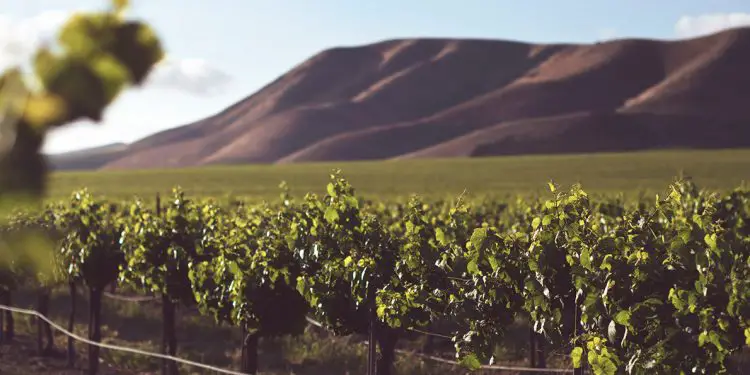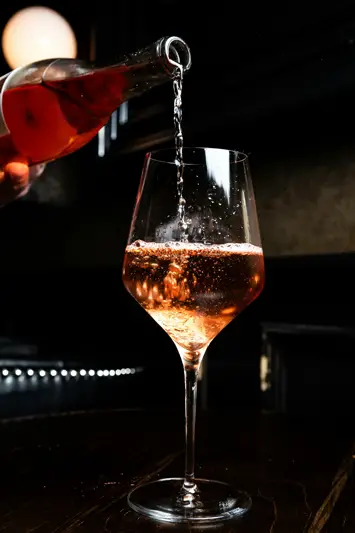Lanzarote: The Latest Wine Tourism Hot Spot

By Kevin Pilley, February 2024
The latest wine region to erupt into the wine tourism atlas is Lanzarote.
An ex-investment banker and surfing instructor from Guernsey and a former GB Olympic swimming trials finalist from Sunderland want to make sure we sample the fruits of the La Vendimia grape harvest and find our way to the Rubicon.
Channel islander Ollie Horton gave up the finance industry rat race to become a Lanzarote tour operator, offering wine tourism in the Canaries. When Covid-19 kiboshed that, he set up the Wine Shop Lanzarote with Geordie sports coach, Dan Priestley and Sven Grossenbacher from Switzerland who runs his own media design and media business. Previously he was business development manager in the retail development of Quiksilver Boardriders Shop.
Says Horton: “There are 2000 people working as viticulturalists here and 2300 employed directly in viticulture out of a population of 150,000. The island has 21 wineries including El Grifo, founded in 1775 and one of Spain’s ten oldest. Only 19% of Lanzarote wine leaves the island. The island was unaffected by the phylloxera vine disease. Ungrafted indigenous varieties include red Listan Negro and white Malvasia Volcanica. Reds are on a roll right now.”

“Leisurely tastings”
Thirty-nine-year-old Horton and Priestley, 36, met on a beach and are members of the Island Surf Club. “He was taking his lifeguard qualification and I was renewing mine,” says Priestley who back home, when a member of Derwentside ASC, was coached by David McNulty, who now coaches Team GB. Dan has worked as a swimming instructor in the US and Australia.
The five-hour 69E La Geria wine tour begins and ends at the Bodega Rubicon and consists of several 45-minute leisurely tastings and typical Canarian nibbles – tapas, garbanzos ( chickpea, pork and chorizo), cherne white fish, calamari, sea salt papas arrugadas (Canarian spicy potatoes), queso frito fried goat’s cheese and fresh local goat’s cheese. Vegetarian options are available too, of course.

Says Horton: “ Only 19% of Lanzarote wine leaves the island. We were unaffected by the phylloxera vine disease. Ungrafted indigenous varieties include red Listan Negro and white Malvasia Volcanica. Reds are on a roll right now. El Grifo is the oldest winery in the Canaries dating back to 1775 it also makes it one of the oldest in Spain. In the last two years they’ve produced their entire wine range with native yeasts from their own vineyard, along with producing a wine from a winter harvest, the first in Europe.
“Sought after wines”
“We stock some of their classics. The Seco Coleccion along with the Ariana, which is a blend of native Listan Negro and Syrah. All of the wines we stock are wines we love and wines that have been rubber-stamped by our wine tour guests too. Being out in the wineries everyday with customers really helps us see what is enjoyed by the public too.”
Horton added: “Best-selling wines would also include Bodega Bermejo, whom we have always worked alongside and we stock seven of their wines for good reason. The Yaiza brand too, produced by Vega de Yuco are some of the most recognisable and sought after wines on the Island. Elsewhere, Bodega Vulcano produce some really authentic and charismatic wines from their small production. Their sweet Moscatel desert wine is the most expensive wine we stock.”
The island has three wine regions _La Geria, Masdache and Ye-Lajares. Since 1993, Lanzarote has had a Regulatory Board or Denominacíon de Origen (D.O.)- Vinos de Lanzarote. But it’s the outside of Lanzarote’s wines which is just as intriguing as what’s inside. Lanzarote wine bottles are unmistakeable. Wineries have signature shapes and colours.

“Oaked-aged”
Ollie recommends wines like Vega de Yuco Yaiza 2020 made from the varietal Malvasia Volcánica. And also Bodega de Bermejos rosado, Brut nature NV sparkly and oaked-aged Listan Negro. Vulcano de Lanzarote’s sweet Moscatel, Bodegas Rubicon 2017 Semi Dulce Malvasia Volcanica and El Grifo Ariana Listan Negro/Syrah too.
Says Priestley : “ On Lanzarote, the vines are protected in giant, golf bunker-like hollows called hoyos. A single vine can have its own 5 metres deep by 10 metres wide living space. Which makes for some of the lowest-density vineyards in the world. So, even with Lanzarote’s typical high fruit load per vine, yields are extremely low.”
The precious vines are further shielded by basalt rock walls above zanjas trenches from the hot Saharan ‘vientos alisios’ trade winds. Rock cairns – ‘abrigos’ ( literally, “coats”) are constructed around the windward side of the hoyo. Says Horton: “The winds act as a natural fungicide.”








